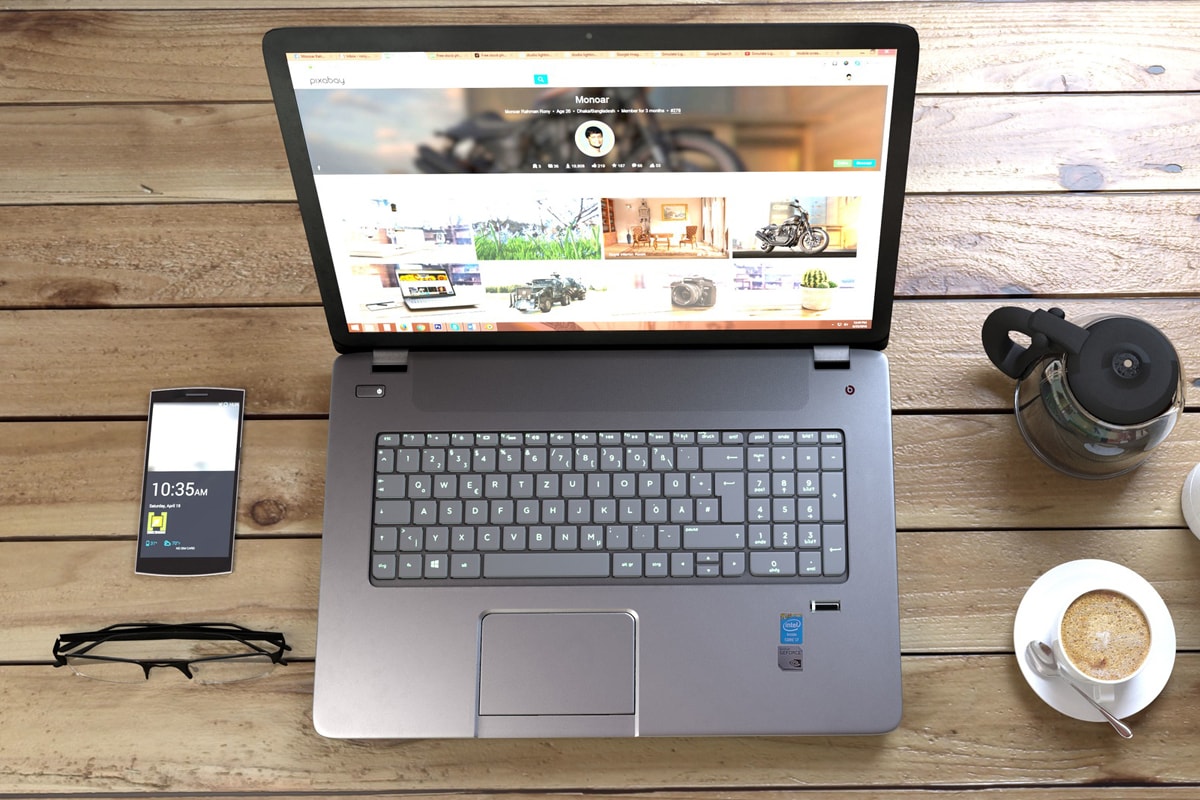
The Power of Aesthetics: How a Visually Appealing and User-Friendly Website Can Boost Your Business’s Customer Base
In an ever increasing digital age, having a strong online presence is crucial for any business looking to attract and retain customers. One of the most important elements of a successful online presence is a visually appealing and user-friendly website. A well-designed website not only helps establish credibility and trust, but it can also play a key role in driving traffic and conversions. In this article, we will explore the ways in which a visually appealing and user-friendly website can help boost your business’s customer base. From the importance of responsive design and calls to action, to the impact of aesthetics on user engagement, we will cover the key elements that make a website effective in attracting and retaining customers.
Importance of a strong online presence
Displaying a strong online presence is critical for any business looking to dominate in this digital age. Your business online presence not only helps establish credibility and trust with potential customers, but it also allows businesses to reach a wider audience and drive more traffic to their website. In addition, a strong online presence can help businesses stay competitive by allowing them to easily connect with customers, provide information and services, and respond to feedback in real-time. With more and more people using the internet to research products and services, it’s essential for businesses to have an online presence that effectively communicates their value proposition and differentiates them from their competitors. A visually appealing and user-friendly website is one of the most important elements of a strong online presence.
The role of a visually appealing and user-friendly website in attracting and retaining customers
Also a well-designed website not only helps your business establish credibility and trust with your potential client , but it also makes it easy for users to find what they’re looking for, navigate the site and perform actions such as making a purchase or contact the business. A visually pleasing design and a consistent layout can also help create an emotional connection with the user and make them more likely to return to the site. A website that is easy to use and navigate can also greatly improve the user experience, which is a key factor in determining whether or not a customer will return to a site.
Furthermore, a responsive design that adapts to different devices, such as smartphones and tablets, can increase the reach of the website and make it accessible to a wider audience. Overall, a visually appealing and user-friendly website can help attract customers, increase engagement and build brand loyalty, which in turn can lead to more conversions and ultimately more revenue for the business.
Purpose of the article
The purpose of this article is to visualize all the ways in which a visually appealing and user-friendly website can help boost your business’s customer base. We aim to highlight the key elements that make a website effective and attractive to current and future customers, also acknowledging the impact of aesthetics, user experience, calls to action, search engine optimization, and multimedia elements. By providing an in-depth examination of these key elements, the article aims to help businesses understand the importance of a strong online presence and the role that a well-designed website can play in driving traffic and conversions. In addition, we aim to provide valuable insights and best practices for website design and optimization, which can help businesses improve their online presence and ultimately increase their bottom line.
The Impact of Aesthetics
The impact of aesthetics on website design cannot be overstated. A visually pleasing design can help establish credibility and trust with potential customers, and can also make a website more memorable and engaging. Aesthetics can play a key role in creating an emotional connection with users, which can lead to increased engagement and ultimately drive more conversions.
Simplicity and consistency in website design can also help to create a clean and organized layout that is easy to navigate, which can improve the user experience. Additionally, the use of color, typography and imagery can all play a role in creating a cohesive and visually appealing design.
Colors can evoke different emotions and should be used strategically, for example, blue is often associated with trust, calmness and security, while red can evoke feelings of excitement and urgency. Good use of typography can make the website look professional and easy to read, while imagery can help to communicate the message and create an emotional connection.
Overall, aesthetics play a crucial role in website design, and it’s essential for businesses to understand how to use design elements to create an aesthetically pleasing and user-friendly website that will help attract and retain customers.
The role of design in building credibility and trust
A major component of any successful business is design , because it is able to provide a sense of credibility and trust to prospective customers. By utilizing design elements in websites and promotional materials, businesses are able to project an image of professionalism and reliability that customers can trust. Design also allows businesses to separate themselves from the competition, as a unique design can make a company stand out from the crowd. Through using design in marketing materials and websites, businesses are able to provide customers with a sense of trust and respect that will keep them coming back for more.
The impact of color, typography, and imagery on user engagement
The use of color, typography, and imagery on user engagement is significant as it can affect how users perceive and interact with a website or app. Color can evoke emotions and create a sense of brand identity, while typography can influence readability and the overall aesthetic of a design. Imagery can also play a crucial role in user engagement as it can help to communicate a message and provide context for the content on a page. When used effectively, these elements can help to create an engaging and visually appealing user experience that can increase the likelihood of user retention and conversion. However, it’s important to consider accessibility and user-centered design principles when working with these elements.
User Experience
A good web user experience is one that is intuitive, efficient, and satisfying for potential clients. It should be easy to find the information needed and complete desired tasks, whether that is making a purchase, filling out a form, or accessing content. The website or application should be visually appealing and easy to navigate, with a clear hierarchy of information and consistent layout. The user interface should be easy to understand and use, with clear calls to action and minimal clutter. Additionally, a good web user experience should be accessible to users with disabilities and optimized for various devices and screen sizes. A good web user experience also should consider the user’s context and goals, providing the right information at the right time. Additionally, it should be easy for users to provide feedback, and use it to improve the website. All of this is accomplished by following user-centered design principles, conducting user research, testing and iterating.
The importance of responsive design
Responsive design is crucial for creating a good user experience on your website. It is the technique by which a website or application automatically adapts to its targeted screen size and resolution for the device it is being viewed on. This ensures a good and optimal viewing experience, regardless of which device is accessing the site whether it is a desktop, tablet, or smartphone.
The importance of responsive design is driven by the increasing use of mobile devices to access the web. According to recent statistics, more than half of all web traffic comes from mobile devices. If a website or application is not optimized for mobile, users may have a difficult time navigating or reading the content, leading to frustration and a high bounce rate. A responsive design allows for a consistent user experience across all devices, improving user engagement and conversion rates.
The role of navigation and organization in creating a user-friendly website
It is clear that navigation and organization play a critical role in creating a user-friendly website. Navigation is you can move through the site, while organization refers to information presented structurally sound.
A well-designed navigation system should make it easy for users to find the information they need and complete their desired tasks. This can be achieved by using clear and descriptive labels, consistent navigation elements, and intuitive organization of content. A typical pattern that is widely used is the use of a main navigation bar at the top of the page, with drop-down menus for sub-categories. Additionally, it’s also essential to include a search bar, site map, and a clear call to action.
In summary, good navigation and organization are essential for creating a user-friendly website. They help users find the information they need and complete their desired tasks quickly and easily. Additionally, it helps to improve the overall aesthetic and usability of the website, leading to increased user engagement and satisfaction.

The impact of load time and page speed on user engagement
Loads time and page speed can have a significant impact on user engagement. Load time refers to the time it takes for a website or application to load and be fully functional, while page speed refers to the time it takes for that specific page to load.
Users expect websites to load quickly and efficiently, a slow load time can lead to frustration by the end user and a high bounce rate. Research shows that users tend to abandon a website if it takes more than 3 seconds to load and that a one-second delay in page load time can result in a 7% decrease in conversions. Additionally, slow page speed can also negatively impact search engine rankings, as search engines such as Google consider page speed as a ranking factor.
To improve load time and page speed, it’s important to optimize images, minify code, and reduce the number of HTTP requests. Additionally, using a content delivery network (CDN) can help to distribute the load and improve the speed of the site. It’s also important to use browser caching, which stores frequently accessed data on the user’s device, so that it doesn’t have to be loaded each time the user visits the site.
In summary, load time and page speed are critical factors in creating a good user experience. A slow load time can lead to frustration and a high bounce rate, while fast page speed can improve user engagement, increase conversions and improve search engine rankings. It’s important to regularly monitor and optimize load time and page speed, to ensure that users have a fast and efficient experience when they visit your website.
Calls to Action (CTA)
Consider using a call to action or CTA, that’s part of a controlled collaboration towards your products or message. CTAs consist of buttons, links, and other elements that prompt a specific action, such as making a purchase, signing up for a newsletter, or downloading a resource.
Providing clear and actionable instructions on what they should do next can help increase conversions and improve engagement, by making it easy for users to take action.
What are the best practices to follow when creating CTAs. Consider these options:
Use action-oriented language that clearly communicates the benefit of the action, such as “Sign up now” or “Download our guide”
Make the CTA stand out visually, by using contrasting colors, or by placing it in a prominent location
Place the CTA in logical locations, such as at the end of a blog post or in the header or footer of a website
Use A/B testing to determine which CTA’s are most effective, and use the results to improve conversions over time
In summary, calls to action are an essential component of a user-friendly website or application. They provide clear and actionable instructions on what users should do next, and can help to increase conversions and improve user engagement. By following best practices, such as using action-oriented language, making the CTA stand out, and placing it in logical locations, you can create effective CTAs that help guide users through the conversion funnel and improve the overall user experience.

Multimedia Elements
Multimedia enhances your experience on a website or a marketing campaign. These include, but are not limited to:
Photographs, illustrations, and infographics can be used to break up text and add visual interest to a page.
Video should be used to convey information, demonstrate products or services, or tell a story.
Podcasts, music, and sound effects can be used to create a more immersive experience for your potential client.
Animation, such as GIFs or short videos, can be used to grab attention and convey information in a fun and engaging way.
Multimedia has become increasingly important in today’s digital landscape the effects can grab your attention and keep the end user engaged. They can help to break up text and make a website more visually appealing. They can also be used to create a more immersive experience for the user, helping them to better understand and engage with the content. Additionally, multimedia elements can be shared easily across social media, which helps to increase the reach and engagement of the campaign. Overall, multimedia elements are a powerful tool for enhancing user engagement and driving conversions.
The role of multimedia in storytelling and building emotional connections
Multimedia holds a great relevance to storytelling. It can form a setting to share heartfelt emotions, while also providing an interactive and absorbing way to communicate information. Combining visuals, videos, sound, and text makes a narrative more captivating, thus creating a vivid experience for the user. Furthermore, multimedia can be used to offer background details that can enrich the story and boost the comprehension of the audience. As an example, the utilization of historical visuals or video clips can help to give an explanation about a story in a way that words alone cannot. Additionally, the combination of diverse mediums allows for multiple point of views to be examined and shown, further enriching the narrative.
To summarize, multimedia is a potent tool for storytelling that can build a stronger emotional connection and make a story memorable and effective.
Best practices for integrating multimedia into website design
Multimedia is an essential component when it comes to telling a story. It is capable of producing a setting that can illustrate emotional experiences and communicate data in a way that is more engaging and interactive. Through the addition of visuals, recordings, sound, and text, multimedia ensures the story’s sensory allure and captures the audience’s attention. Multimedia can provide an immersive encounter for the end user by constructing a stronger emotional connection with the story, making it more unforgettable and effective.
Here are a few best practices for incorporating multimedia into website design:
Using Multimedia Intentionally: Incorporate multimedia elements like videos, images, and audio files with a precise purpose, such as to improve user experience, bolster branding, or provide information.
Optimization: Optimize multimedia elements for web performance by compressing pictures, utilizing suitable video formats, and making sure fast loading times.
Accessibility: Ensure that multimedia elements are available to people with disabilities.
Responsiveness: Make certain that visual and audio components are adjustable to different display sizes, so people can view them on any device.
Brand consistency: Make sure that the use of multimedia elements is compatible with your company’s policies, so a unified and expert look is maintained.
User control: Let users have control over the multimedia elements, such as the ability to pause or mute videos, or adjust the sound level of audio files.
Mobile-first design: Consider mobile phones when creating and including multimedia elements, since a large amount of web traffic today comes from mobile devices.
Error handling: Prepare for error handling and provide supplemental options, such as alternate text or a substitute version of the video, in case the multimedia elements do not load.
Summary of key points:
Integrating multimedia into website design is a crucial aspect of enhancing user experience and delivering information effectively. Some of the key best practices for integrating multimedia into website design include purposeful use, optimization for web performance, accessibility, responsiveness, brand consistency, user control, mobile-first design, and error handling.
The importance of ongoing website optimization:
Ongoing website optimization is essential to ensure that the website remains relevant and effective in delivering its purpose. Regular review and updates of multimedia elements, as well as other website components, can help keep the website fresh, up-to-date, and optimized for both users and search engines.
If you would like to deepen your knowledge on combining multimedia into website design and optimizing your website, it is suggested to seek out a web design expert. This will provide you with a tailored response and tips that align with your ambitions and requirements. Additionally, there is a wealth of resources available on the internet, such as blog posts, tutorials, and case studies, that can provide further clarity on website design and optimization.


